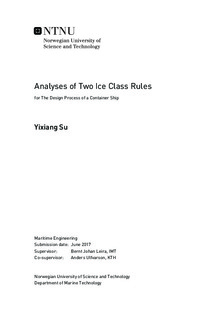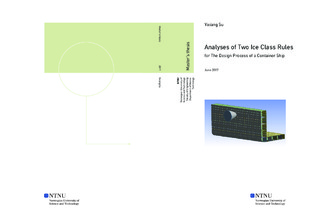| dc.description.abstract | The Finnish-Swedish Ice Class Rules (FSICR) has a long history. Having being tested by countless ships, it becomes the authority in Baltic Sea region. International Association of Classification Societies Polar Class (IACS PC) is first published in 2007, and it unifies other rules together.
In this thesis, all the scenarios are within safety range. FSICR design with fewer materials are more competitive than IACS design.
According to definition of ice class, for level ice, IACS PC 7 are equivalent to FSICR IA and should be higher than FSICR IC. It is true at the design stage. The scantling from IACS PC7 design are larger than FSICR IC design, but not too much. As a result, the strength from IACS design is supposed to be higher than FSICR design.
However, according to the results above, the situation was a little different for iceberg scenario. For case v to viii, the results opposites the expectation. The FSICR design showed the same or even higher strength than IACS design. The randomness of the ice crashing process was the main reason. For example, the crash of ice might create new sharp points (figure 5-7), which would cause secondary damage in a single collision process.
The ice state changes all the time. In Baltic Sea, there are not only level ice in winters, but also ice ridges. A vessel may endanger more than once collisions in an area with high density of ice ridges or icebergs. The large plastic deformation from the first-time collision definitely can be a hazard to the vessel.
In the collision process, the initial kinematic energy of ice transfers to internal energy of structure (plastic deformation and damage), friction energy, crashing energy of ice and the left kinematic energy of ice.
To avoid damage or large plastic deformation, some measures can be taken. Vessel displacement, engine output, materials, and frame arrangement are the main factors in the design process for both rules. Apart from them, some rule-defined factors also influence the designs. for example, the crashing failure factor in IACS PC and the height of load area in FSICR. Although the design process is rigid, some variables above can be changed for both ice class rules. At the design stage, on the one hand, the number of stiffeners can be increased within the ice belt. On the other hand, the frame spacing can be decreased. These two methods are claimed in many ice rules. However, the potential stress concentration need to be considered. Moreover, a stronger material can be used. But the cost is to be rise substantially.
The safety and cost are the two major considerations. To save cost as much as possible, the selection of rules is supposed to relate with the ice state, and with or without escort. FSICR is intended for only first-year level ice, and the grading classification is less in numbers but more precise compared with IACS PC. Combined with the simulation results, FSICR is more suitable for designing ships sailing in Baltic Sea. | |

